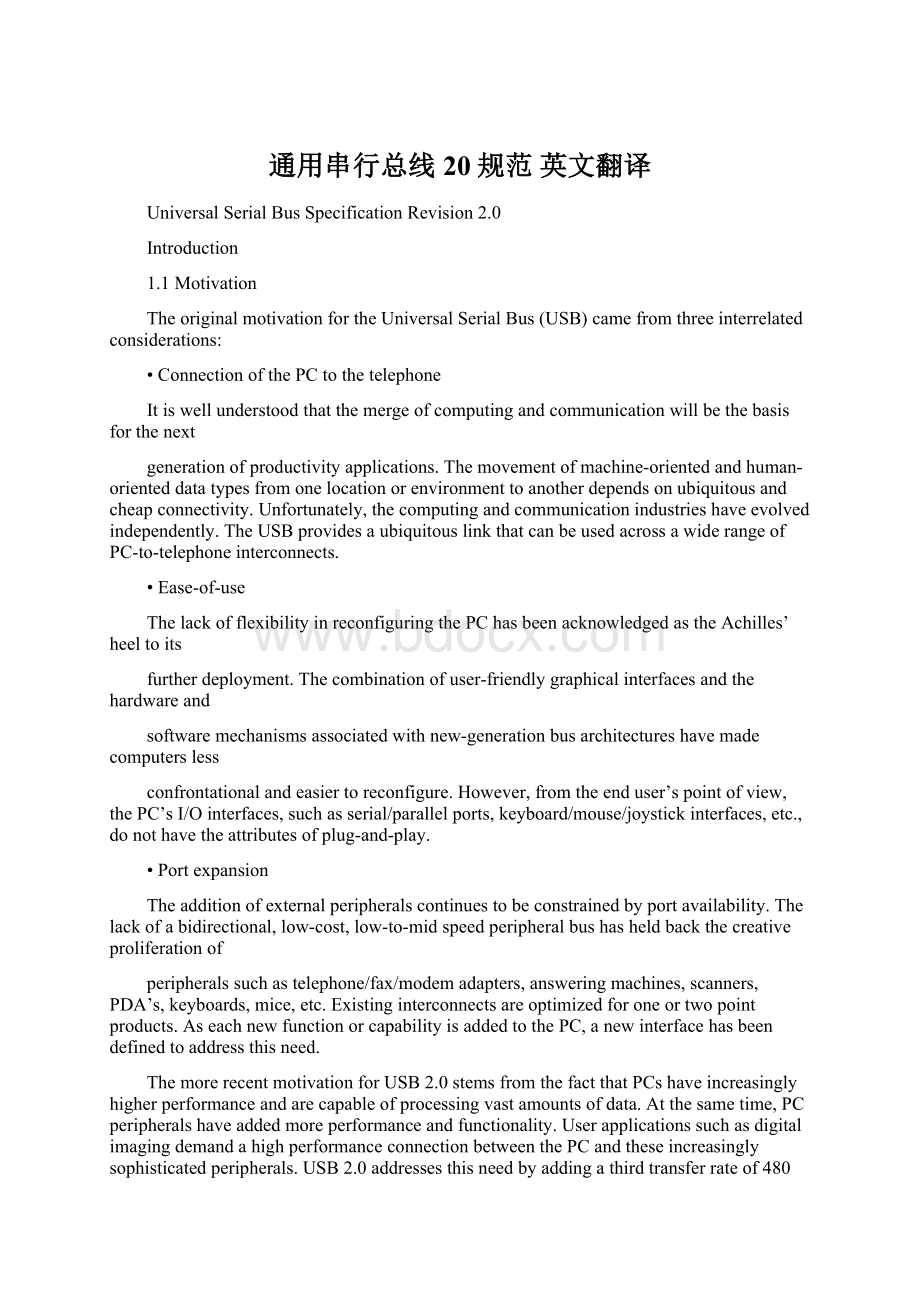通用串行总线20规范 英文翻译.docx
《通用串行总线20规范 英文翻译.docx》由会员分享,可在线阅读,更多相关《通用串行总线20规范 英文翻译.docx(14页珍藏版)》请在冰豆网上搜索。

通用串行总线20规范英文翻译
UniversalSerialBusSpecificationRevision2.0
Introduction
1.1Motivation
TheoriginalmotivationfortheUniversalSerialBus(USB)camefromthreeinterrelatedconsiderations:
•ConnectionofthePCtothetelephone
Itiswellunderstoodthatthemergeofcomputingandcommunicationwillbethebasisforthenext
generationofproductivityapplications.Themovementofmachine-orientedandhuman-orienteddatatypesfromonelocationorenvironmenttoanotherdependsonubiquitousandcheapconnectivity.Unfortunately,thecomputingandcommunicationindustrieshaveevolvedindependently.TheUSBprovidesaubiquitouslinkthatcanbeusedacrossawiderangeofPC-to-telephoneinterconnects.
•Ease-of-use
ThelackofflexibilityinreconfiguringthePChasbeenacknowledgedastheAchilles’heeltoits
furtherdeployment.Thecombinationofuser-friendlygraphicalinterfacesandthehardwareand
softwaremechanismsassociatedwithnew-generationbusarchitectureshavemadecomputersless
confrontationalandeasiertoreconfigure.However,fromtheenduser’spointofview,thePC’sI/Ointerfaces,suchasserial/parallelports,keyboard/mouse/joystickinterfaces,etc.,donothavetheattributesofplug-and-play.
•Portexpansion
Theadditionofexternalperipheralscontinuestobeconstrainedbyportavailability.Thelackofabidirectional,low-cost,low-to-midspeedperipheralbushasheldbackthecreativeproliferationof
peripheralssuchastelephone/fax/modemadapters,answeringmachines,scanners,PDA’s,keyboards,mice,etc.Existinginterconnectsareoptimizedforoneortwopointproducts.AseachnewfunctionorcapabilityisaddedtothePC,anewinterfacehasbeendefinedtoaddressthisneed.
ThemorerecentmotivationforUSB2.0stemsfromthefactthatPCshaveincreasinglyhigherperformanceandarecapableofprocessingvastamountsofdata.Atthesametime,PCperipheralshaveaddedmoreperformanceandfunctionality.UserapplicationssuchasdigitalimagingdemandahighperformanceconnectionbetweenthePCandtheseincreasinglysophisticatedperipherals.USB2.0addressesthisneedbyaddingathirdtransferrateof480Mb/stothe12Mb/sand1.5Mb/soriginallydefinedforUSB.USB2.0isanaturalevolutionofUSB,deliveringthedesiredbandwidthincreasewhilepreservingtheoriginalmotivationsforUSBandmaintainingfullcompatibilitywithexistingperipherals.Thus,USBcontinuestobetheanswertoconnectivityforthePCarchitecture.Itisafast,bi-directional,isochronous,low-cost,dynamicallyattachableserialinterfacethatisconsistentwiththerequirementsofthePCplatformoftodayandtomorrow.
1.2ObjectiveoftheSpecification
Thisdocumentdefinesanindustry-standardUSB.Thespecificationdescribesthebusattributes,theprotocoldefinition,typesoftransactions,busmanagement,andtheprogramminginterfacerequiredtodesignandbuildsystemsandperipheralsthatarecompliantwiththisstandard.
Thegoalistoenablesuchdevicesfromdifferentvendorstointeroperateinanopenarchitecture.ThespecificationisintendedasanenhancementtothePCarchitecture,spanningportable,businessdesktop,andhomeenvironments.ItisintendedthatthespecificationallowsystemOEMsandperipheraldevelopersadequateroomforproductversatilityandmarketdifferentiationwithouttheburdenofcarryingobsoleteinterfacesorlosingcompatibility.
1.3ScopeoftheDocument
ThespecificationisprimarilytargetedtoperipheraldevelopersandsystemOEMs,butprovidesvaluableinformationforplatformoperatingsystem/BIOS/devicedriver,adapterIHVs/ISVs,andplatform/adaptercontrollervendors.Thisspecificationcanbeusedfordevelopingnewproductsandassociatedsoftware.
1.4USBProductCompliance
AdoptersoftheUSB2.0specificationhavesignedtheUSB2.0AdoptersAgreement,whichprovidesthemaccesstoareciprocalroyalty-freelicensefromthePromotersandotherAdopterstocertainintellectualpropertycontainedinproductsthatarecompliantwiththeUSB2.0specification.AdopterscandemonstratecompliancewiththespecificationthroughthetestingprogramasdefinedbytheUSBImplementersForum.ProductsthatdemonstratecompliancewiththespecificationwillbegrantedcertainrightstousetheUSBImplementersForumlogoasdefinedinthelogolicense.
1.5DocumentOrganization
Chapters1through5provideanoverviewforallreaders,whileChapters6through11containdetailedtechnicalinformationdefiningtheUSB.
•PeripheralimplementersshouldparticularlyreadChapters5through11.
•USBHostControllerimplementersshouldparticularlyreadChapters5through8,10,and11.
•USBdevicedriverimplementersshouldparticularlyreadChapters5,9,and10.
ThisdocumentiscomplementedandreferencedbytheUniversalSerialBusDeviceClassSpecifications.Deviceclassspecificationsexistforawidevarietyofdevices.PleasecontacttheUSBImplementersForumforfurtherdetails.
ReadersarealsorequestedtocontactoperatingsystemvendorsforoperatingsystembindingsspecifictotheUSB.
Background
ThischapterpresentsabriefdescriptionofthebackgroundoftheUniversalSerialBus(USB),includingdesigngoals,featuresofthebus,andexistingtechnologies.
2.1GoalsfortheUniversalSerialBus
TheUSBisspecifiedtobeanindustry-standardextensiontothePCarchitecturewithafocusonPCperipheralsthatenableconsumerandbusinessapplications.ThefollowingcriteriawereappliedindefiningthearchitecturefortheUSB:
•Ease-of-useforPCperipheralexpansion
•Low-costsolutionthatsupportstransferratesupto480Mb/s
•Fullsupportforreal-timedataforvoice,audio,andvideo
•Protocolflexibilityformixed-modeisochronousdatatransfersandasynchronousmessaging
•Integrationincommoditydevicetechnology
•ComprehensionofvariousPCconfigurationsandformfactors
•Provisionofastandardinterfacecapableofquickdiffusionintoproduct
•EnablingnewclassesofdevicesthataugmentthePC’scapability
•FullbackwardcompatibilityofUSB2.0fordevicesbuilttopreviousversionsofthespecification
2.2TaxonomyofApplicationSpace
Figure2-1describesataxonomyfortherangeofdatatrafficworkloadsthatcanbeservicedoveraUSB.Ascanbeseen,a480Mb/sbuscomprehendsthehigh-speed,full-speed,andlow-speeddataranges.Typically,high-speedandfull-speeddatatypesmaybeisochronous,whilelow-speeddatacomesfrominteractivedevices.TheUSBisprimarilyaPCbusbutcanbereadilyappliedtootherhost-centriccomputingdevices.ThesoftwarearchitectureallowsforfutureextensionoftheUSBbyprovidingsupportformultipleUSBHostControllers.
Figure2-1.ApplicationSpaceTaxonomy
2.3FeatureList
TheUSBSpecificationprovidesaselectionofattributesthatcanachievemultipleprice/performanceintegrationpointsandcanenablefunctionsthatallowdifferentiationatthesystemandcomponentlevel.
Featuresarecategorizedbythefollowingbenefits:
Easytouseforenduser
•Singlemodelforcablingandconnectors
•Electricaldetailsisolatedfromenduser(e.g.,busterminations)
•Self-identifyingperipherals,automaticmappingoffunctiontodriverandconfiguration
•Dynamicallyattachableandreconfigurableperipherals
Widerangeofworkloadsandapplications
•Suitablefordevicebandwidthsrangingfromafewkb/stoseveralhundredMb/s
•Supportsisochronousaswellasasynchronoustransfertypesoverthesamesetofwires
•Supportsconcurrentoperationofmanydevices(multipleconnections)
•Supportsupto127physicaldevices
•Supportstransferofmultipledataandmessagestreamsbetweenthehostanddevices
•Allowscompounddevices(i.e.,peripheralscomposedofmanyfunctions)
•Lowerprotocoloverhead,resultinginhighbusutilization
Isochronousbandwidth
•Guaranteedbandwidthandlowlatenciesappropriatefortelephony,audio,video,etc.
Flexibility
•Supportsawiderangeofpacketsizes,whichallowsarangeofdevicebufferingoptions
•Allowsawiderangeofdevicedataratesbyaccommodatingpacketbuffersizeandlatencies
•Flowcontrolforbufferhandlingisbuiltintotheprotocol
Robustness
•Errorhandling/faultrecoverymechanismisbuiltintotheprotocol
•Dynamicinsertionandremovalofdevicesisidentifiedinuser-perceivedreal-time
•Supportsidentificationoffaultydevices
SynergywithPCindustry
•Protocolissimpletoimplementandintegrate
•ConsistentwiththePCplug-and-playarchitecture
•Leveragesexistingoperatingsysteminterfaces
Low-costimplementation
•Low-costsubchannelat1.5Mb/s
•Optimizedforintegrationinperipheralandhosthardware
•Suitablefordevelopmentoflow-costperipherals
•Low-costcablesandconnectors
•Usescommoditytechnologies
Upgradepath
•ArchitectureupgradeabletosupportmultipleUSBHostControllersinasystem
ArchitecturalOverview
ThischapterpresentsanoverviewoftheUniversalSerialBus(USB)architectureandkeyconcepts.TheUSBisacablebusthatsupportsdataexchangebetweenahostcomputerandawiderangeofsimultaneouslyaccessibleperipherals.TheattachedperipheralsshareUSBbandwidththroughahostscheduled,token-basedprotocol.Thebusallowsperipheralstobeattached,configured,used,anddetachedwhilethehostandotherperipheralsareinoperation.
LaterchaptersdescribethevariouscomponentsoftheUSBingreaterdetail.
3.1USBSystemDescription
AUSBsystemisdescribedbythreedefinitionalareas:
•USBinterconnect
•USBdevices
•USBhost
TheUSBinterconnectisthemannerinwhichUSBdevicesareconnectedtoandcommunicatewiththehost.Thisincludesthefollowing:
•BusTopology:
Connectionmodelbetwe